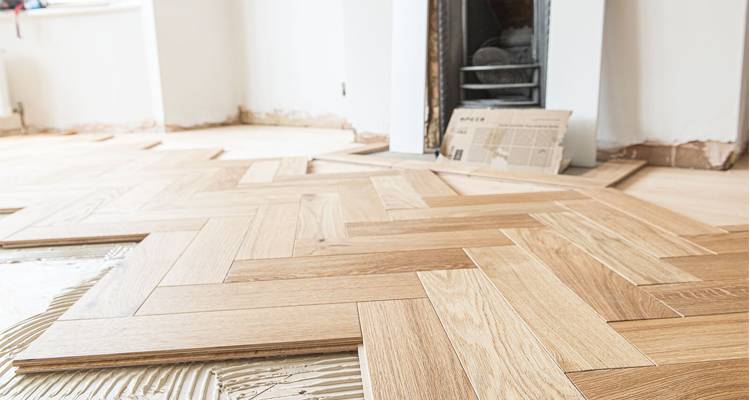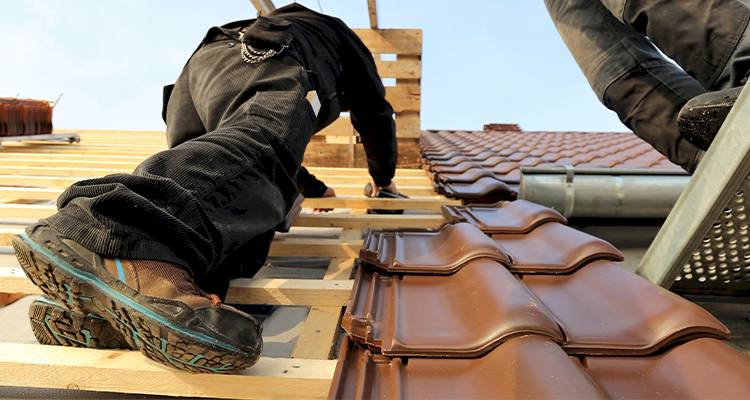Scaffolding Cost
- The average cost of scaffolding hire is around £4,500.
- It usually takes less than a day for scaffolding to be erected.
- Scaffolding costs in 2026 by size and type.
- How long the job takes and what's typically involved.
- How to find a local scaffolder using MyJobQuote.
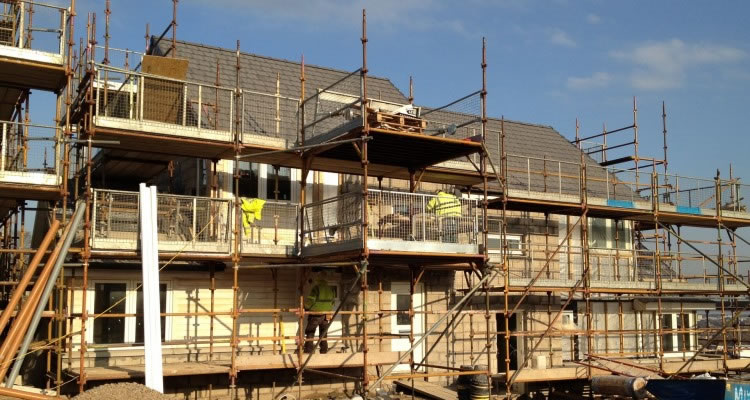
£4,500
Table of Contents
- How Much is Scaffolding Hire?
- Labour Cost for Scaffolding Hire & Timescales
- When Do You Need to Hire Scaffolding?
- What Is Scaffolding?
- Factors That Impact Scaffolding Costs
- What's Involved in Hiring Scaffolding?
- What are the Different Types of Scaffolding?
- Scaffolding Regulations
- Removing Scaffolding
- Checklist: Hiring a Scaffolder in the UK
How Much is Scaffolding Hire?
The costs to hire scaffolding vary depending on the amount of scaffolding you need. This is a combination of your property type as well as the work that will be completed. You will also have to hire the scaffolding for a minimum term which is usually between six to eight weeks.
If you only require a small tower. This would be to complete a job like fixing hip tiles or guttering. You can expect to pay a total of somewhere between £640 and £1,210 for the total hire.
If you need to hire scaffolding for a large project, like painting the outside of a detached home, the price will be much higher. You should budget for anything between £7,500 and £11,500.
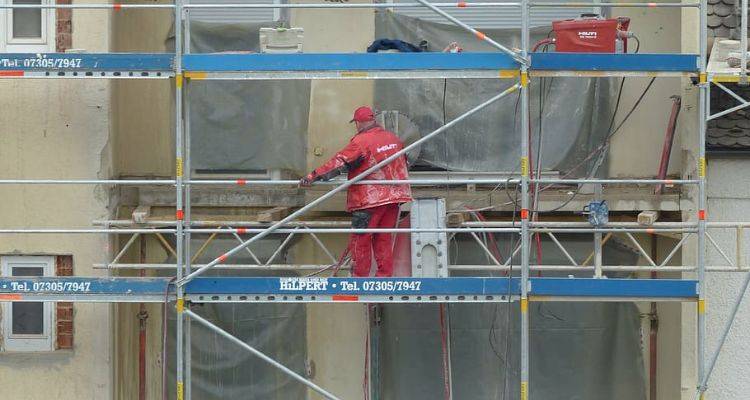
Sometimes the scaffolding is included in your contractor’s price. Other times, it’s hired separately. For small or short jobs, separate hire can be impractical because many firms work to minimum hire periods and site set-up still takes time.
In practice, minimum hire terms and set-up costs can make short, very small jobs less viable as a standalone hire.
How can I tell when it is best practice to hire scaffolding as opposed to using a ladder to access a roof for DIY work? Is it related to the extent of the work? How about the height of the house? Are there any other factors I should consider?
Scaffolding Price List
So, what's the cost of scaffolding?
When you hire scaffolding, you will be charged based on several factors. You will have to pay for the hire of your scaffolding, as well as to have it put up and taken down, combined with the type of job you need the scaffolding for, which means that scaffolding hire costs vary a lot.
In most cases, you will pay per week that you hire the scaffolding for. The following tables should give you a good idea of how much it will cost to hire scaffolding for your project.
When you hire scaffolding, you will do so for a fixed-term period. Usually, 6 or 8 weeks is the minimum term. The following gives you an indication of the total cost for a range of scenarios:
| Scenario | Cost of 6-week hire | Cost of 8-week hire |
|---|---|---|
| Tower to fix bottom hip tiles | £640 – £970 | £770 – £1,210 |
| Scaffolding bridge over a conservatory | £3,150 – £5,850 | £4,050 – £7,650 |
| Scaffolding at the front of the property for roofing | £3,725 – £4,925 | £4,825 – £6,025 |
| Scaffolding around a semi for roofing | £5,350 – £6,250 | £6,850 – £8,050 |
| Scaffolding for chimney work | £3,150 – £3,750 | £3,950 – £4,750 |
| Scaffolding at the front of the property for painting | £4,100 – £5,000 | £5,200 – £6,400 |
| Scaffolding around a semi for painting | £5,900 – £6,800 | £7,400 – £8,600 |
| Scaffolding around a detached property for painting | £7,500 – £9,000 | £9,500 – £11,500 |
When you hire scaffolding, the cost will be based on the materials needed to create the structure you need, as well as the cost to erect and strike the construction.
The following table gives you the costs of the materials needed to build a scaffolding:
| Item | Average Cost Per Week |
|---|---|
| Standard scaffolding | £16 – £20 |
| Additional materials for complex jobs | £9 – £15 |
| Edge protectors and handrails | £10 – £15 |
Here are some example prices for typical scaffolding hires. These are average prices and will vary depending on multiple factors:
| Example Job | Average Cost Per Week |
|---|---|
| Four-storey semi-detached house – scaffolding to access the roof | £1,000 – £1,250 |
| Three-storey semi-detached house – all three walls | £900 – £1,150 |
| Two-storey semi-detached house – all three walls | £750 – £900 |
| Terraced house – one wall | £550 – £700 |
| Access Tower – to repair gutters | £65 – £120 |
| Scaffolding over a conservatory | £450 – £900 |
| Chimney access scaffolding | £400 – £500 |
Scaffolding Cost Calculator
Labour Cost for Scaffolding Hire & Timescales
The labour scaffolding costs will depend largely on the size of the scaffolding you need to construct, as well as how easy it is to access the locations.
The following table gives you some example labour costs, along with the time taken to put up and take down the scaffolding:
| Scenario | Duration | Average Labour Costs |
|---|---|---|
| Tower to fix bottom hip tiles | 2 – 4 hours | £225 – £275 |
| Scaffolding bridge over a conservatory | 2 – 4 hours | £425 – £475 |
| Scaffolding at the front of the property for roofing | 0.5 – 1 day | £400 – £450 |
| Scaffolding around a semi for roofing | 0.5 – 1 day | £825 – £875 |
| Scaffolding for chimney work | 1 – 2 days | £725 – £775 |
| Scaffolding at the front of the property for painting | 0.5 – 1 day | £475 – £525 |
| Scaffolding around a semi for painting | 1 – 1.5 days | £1,075 – £1,125 |
| Scaffolding around a detached property for painting | 1 – 2 days | £1,475 – £1,525 |
When Do You Need to Hire Scaffolding?
The truth is, it’s really depends on the job, how high it is, and how long you think you’ll be up there. There isn’t a single ‘height rule’ — short, simple tasks may be fine from a ladder. Anything longer or more involved is safer and quicker on a scaffold.
Below, we’ve split it up by common projects with the usual setup a local scaffolder will recommend.
Roofing and Chimney Work
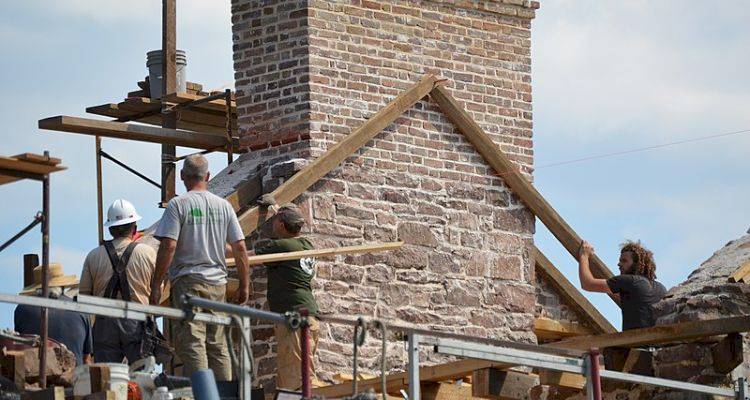
- Full roof replacement or large repairs — Normally needs a full wrap (independent) scaffold around the house with one or two working lifts, plus debris netting. Safe access, edge protection and easy material handling.
- Ridge tiles / valleys / flashing — Often a single lift scaffold to the eaves/front elevation is more than enough. Some roofers use roof ladders for tiny patches, but a platform is safer and tidier for anything more than a quick fix. You can check replacing ridge tiles costs for an idea of prices.
- Chimney repairs / capping — More often than not, a specialist chimney scaffold built off the roof (saddle/ridge access) with guardrails. But if it’s tricky to get to, a small gable tower will probably be tied into the scaffold.
- Over conservatories / glass roofs — A scaffold bridge (spanning beam) to avoid loading the conservatory — no walking on roofs or lean-to’s.
Exterior Painting and Masonry
- Whole house repaint — A wrap scaffold (front only or all sides) with one or two lifts so the painter can move safely and keep a steady pace. Towers work for small terraces, but full scaffold is much quicker and safer for lengthier jobs. Get an idea of house painting costs before you book.
- Localised prep (windows, sills, fascia): A mobile/tower scaffold is often okay, moved along as you go. If your home is higher or has long runs, your local specialist will still prefer a fixed lift so they’re not forever shifting a tower.
Rendering, Repointing and Cladding
- Rendering/re-rendering — A wrap scaffold with continuous boarded lifts and debris netting (or sheeting) — you need stable platforms for mixing, applying and working the finish.
- Repointing brickwork — Classically one or two fixed lifts to the elevations being worked, with toe-boards for safe tooling and dust control.
- External cladding — Independent scaffold with decent access to corners or soffits. Your local installer will need hands-free working at set heights for fixings and trims. Have a look at external cladding costs if you’re weighing it up.
Gutters, Fascia and Soffits
- Full replacement or long runs — A single lift scaffold at eaves height makes life a lot easier (and neater) than moving a tower every few metres. You can check gutter replacement costs to budget ahead.
- Small local repairs — If it’s easy to get to and it’s genuinely a quick job, then a mobile tower may be plenty.
Solar Panels
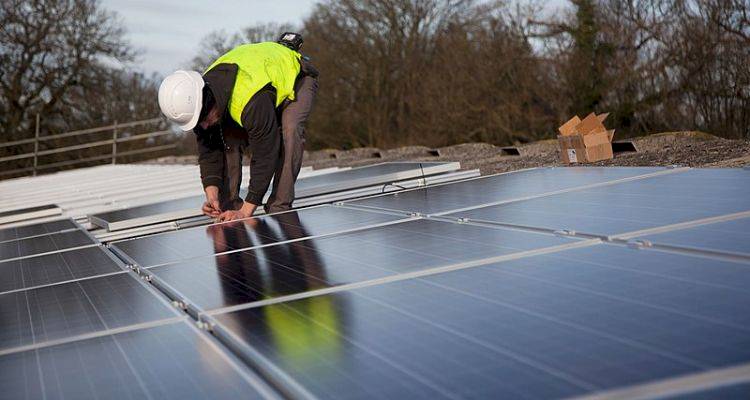
- Standard installs — A single lift scaffold to the working elevation, sometimes with a loading bay for panels. Gives safe edge protection and a platform for rail fixing and wiring. See average solar panel installation costs before you commit.
What is the best scaffolding to use on a small detached house to install solar panels?
Loft Conversions and Dormers
- Dormers, roof alterations, steels — A full wrap scaffold with loading bay is incredibly common. If yours is a weather-sensitive build, you might see a temporary roof (“tin hat”) to keep the interior dry while the roof’s open. Take a look at typical loft conversion costs for guidance.
- Internal ceiling work — If yours has particularly tall rooms or voids, a birdcage scaffold (flat deck inside) keeps everyone safe.
Extensions and Structural Openings
- New extension shells — Independent scaffold to the new walls with lifts set at masonry courses, adjusted as the build rises. See how double storey extension costs can affect your overall budget.
- Knock-throughs or steel beams — Access depends on the span and height. Expect internal platforms (birdcage) and external lifts if you’re altering the roofline or eaves.
Cleaning, Repairs and Restoration
- Stone or brick cleaning, heritage repairs — Fixed scaffold with careful tie positions, often netted or sheeted for dust and debris control on listed buildings.
A little unsure of what you need?
If you’re quite torn between a tower and a full wrap, it usually comes down to how long you’ll be up there and how far you need to move along the building.
Ask a few local scaffolders for advice and a price, then weigh things up. You can line up free quotes from scaffold specialists near you.
What Is Scaffolding?
Scaffolding is a common part of any construction site. However, if you need scaffolding for a project, it can be confusing as there are so many different types.
Here's a quick rundown of everything you need to know about scaffolding:
What Is Scaffolding Used For?
Scaffolding is used to carry out work at height. It is much safer and easier to work from than a ladder.
It allows multiple workers to work at specific points on a building, and as the structure is secured and supported, it is significantly more stable than a ladder. There is also space for tools and equipment to be brought up to the working location.
How Long Has Scaffolding Been Around?
Modern tube-and-fitting scaffolding developed in the early 20th century — the “Scaffixer” coupler arrived in 1913 and the now-familiar Universal Coupler followed later in the decade.
Since then, systems and standards have evolved rapidly, making modern scaffolds quicker to assemble and much more standardised than earlier approaches.
You can find examples of it all over the world. The materials used vary, but the essential techniques remain the same.
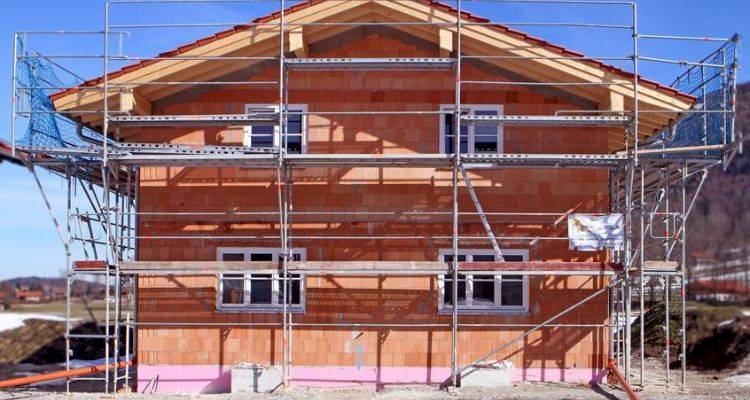
Traditional UK tube-and-fitting scaffolds use three core parts:
- Tubes
- Couplers
- Boards
The tubes form the skeleton of the scaffold. In the UK they’re typically steel or aluminium (bamboo is used in some countries but not in UK practice).
The couplers are the method of joining the tubes together. These days, they are purpose-made components, but in the past, nails, twine, and rope have been used.
The boards are how the standing surfaces are created, and they are usually made from planks of wood.
My neighbour is causing problems - we want to replace the roof tiles on our house, but how would it be possible if he doesn’t allow us access to get scaffolding up on his side?
Why Is Scaffolding So Popular?
Scaffolding is a popular choice because it is safe and efficient. Its design means that it can be very flexible. It is possible to construct scaffolding to allow you exactly the access you need to complete jobs at height.
Scaffolding Terms
There are a lot of terms that are used in the scaffolding industry that can be confusing to an outsider.
Here’s a quick guide to some of the most common terms you may come across when you're looking into scaffolding hire:
- Erection – This is the term used to describe the process of putting the scaffolding up.
- Striking – This is the process of taking the scaffolding down.
- Standards – The vertical tubes that carry the load down to the baseplates/sole boards.
- Bay – This is the term used to describe the internal space between the standards.
- Ledgers – These are the horizontal bars parallel to the building.
- Lift – The height between working levels (rows of ledgers). Often around 2.0 m on independent tied scaffolds, but the exact spacing is set by the design.
- Transoms – These are the horizontal bars supported by the ledgers.
- Platforms – These are made from boards which are supported by the transoms.
- Bracing – This is the system of diagonal poles that stop the scaffolding from falling sideways.
- Façade Bracing – This is the bracing on the side parallel to the building.
- Ledger Bracing – Diagonal bracing fixed to standards/ledgers to prevent sway along the length of the scaffold (often forming a zig-zag pattern on the scaffold face).
- Guardrails – These are the bars that are installed for safety.
- Ties – This is the method used to attach the scaffolding to the wall of the building.
Factors That Impact Scaffolding Costs
There are many factors that contribute to the cost of scaffolding hire. It is worth checking over the list below to identify where the majority of your costs may come from when you are setting your budget:
Location of Property
Where you are in the country will have a big impact on the cost. Hire cost of scaffolding can be up to three times higher in London than in more rural areas.
Generally, costs are higher in cities as there are more limitations on where and how the scaffolding can be erected.
Ease of Access
You will be charged for the time that it takes the scaffolders to put up the scaffolding. So, the harder it is to put it up, the more it will cost you.
If access is clear and there is plenty of space to work, then the costs will be much lower than if the poles and boards have to be carried down a narrow alley, for example.
Number of Storeys
The higher up you need to go, the more it is going to cost. It takes more poles and boards to get higher up, as well as more time to put up and down.
Number of Levels
A larger number of platforms and levels you need in the scaffolding will increase the cost. For example, it can cost more to put up scaffolding for painting a house than for doing a loft conversion.
Length of Hire
The amount of time that you need to hire your scaffolding for will affect the price. Normally, you will pay for a block of 6 or 8-week hire. If you need the scaffolding for longer than that, you will usually have to pay a weekly top-up fee.
Ground Conditions
If the base is soft or jagged (for example, mud, wet ground, flower beds), scaffolders need extra gear (sole boards, bigger base plates, more ties) to make it safe. More kit and more time mean the cost will creep up.
Listed and Heritage Properties
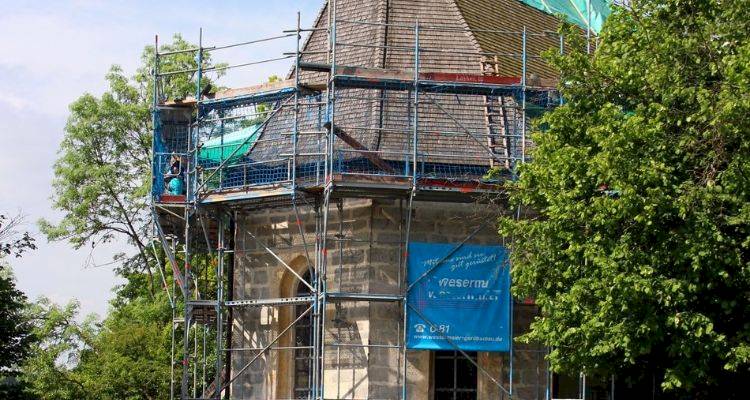
Period features, awkward facades and “no-fix” rules can mean bespoke layouts and careful tie positions. Expect extra design time and a bit more on labour and materials.
Working Over Public Land (Pavements/Highways)
If the scaffold touches a public footpath or road, you’ll usually need a council licence and sometimes traffic management. Fees and time limits vary a little by local authority, so bear this in mind if you’re tight on programme. A highway licence is a legal requirement if your scaffold encroaches on the public highway.
Special Designs and Bridging
Anything out of the ordinary bumps the price. So, things like bridging a conservatory, spanning over glass roofs or building off a roof for chimney access can add to the price.
- Conservatory bridge: typically £450 to £900 per week for the extra beams and setup.
- Chimney access scaffold: often £400 to £500 per week when it needs to run off the ridge with proper guarding.
How much would scaffolding cost for a weekend if I rent it from a scaffolding company?
What's Involved in Hiring Scaffolding?
Getting scaffolding sorted isn’t complicated, but there’s a clear order to things. If you’ve never booked it before, here’s a look at how it usually goes.
Top tip: always line up a few prices before you decide. You can quickly get quotes from local scaffolders — no cost, no difficulty, no pressure to book.
Before the Job Starts
- Site visit and quote — A scaffolder will pop round to size up the job. They’ll look at how easy it is to set up, what the ground’s like, and the kind of scaffold that’ll do the trick.
- Agreeing a start date — Once you’re happy with the quote, you’ll pick a date for the team to come back and put it up. If it needs to go onto a pavement or road, the scaffolder will usually deal with the permits.
- Delivery — On the day, the gear turns up on site ready for the crew to get started.
During the Job
- Base setup — If the ground isn’t perfectly level, they’ll use pads or footings to make sure the scaffold stands solid.
- Putting it up — The scaffold goes up bit by bit, starting at the bottom and working upwards until it’s at the right height with safe access all round.
- Safety checks — Guardrails, toe boards, netting – all added as needed so the structure is safe to climb and work from.
After the Job
- Dismantling — Once your project’s finished, the team comes back to strike (take down) the scaffold. It usually takes about the same time as it did to put it up.
- Tidying up — Everything’s cleared away – boards, tubes, fittings – so you’re not left with any clutter.
Do you need to put scaffolding up to cap a chimney on a terrace house?
What are the Different Types of Scaffolding?
When it comes to scaffolding, there are many different types to choose from. When making the decision, it often depends on the job and the building.
Most scaffolding companies will assess your site and tell you which sort of scaffolding they will provide. This is because there are a lot of engineering and safety considerations when choosing a type of scaffolding.
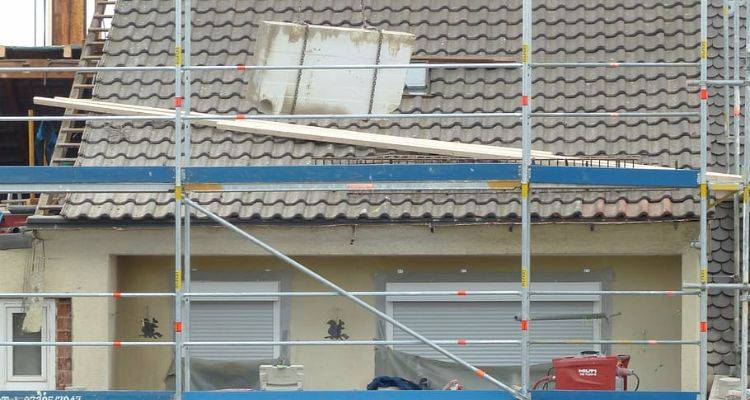
The types of scaffolding available can be broken down into three main types, which are then further divided:
Supported Scaffolding
This is the most common type of scaffolding. It is what you most likely picture when you think of scaffolding. This is built from the bottom up and is often the easiest and most simple option.
Birdcage Scaffolding
This type of scaffolding is mostly used for indoor projects. It often provides access to one single elevated level.
It is used by decorators and carpenters to access ceilings. It’s a grid of multiple bays (rows of standards in both directions) with boarded platforms, typically used for safe access to ceilings or high internal spaces.
Double Scaffolding
This type of scaffolding is used when it is not possible to tie the scaffolding to the building. An extra set of standards is built about 1.5m away from the initial frame. These are then tied together using transoms.
Patented Scaffolding
Modular systems with engineered components that speed erection and improve consistency. They cover most common configurations; non-standard layouts still need specific design.
Single Scaffolding
Single or “putlog” scaffolding is traditionally used for brickwork, with putlogs built into the wall. Modern UK domestic/external work more commonly uses independent (tied) scaffolds.
Steel Scaffolding
In UK practice, tube-and-fitting scaffolds use steel (or aluminium) tubes connected with purpose-made couplers and set on steel baseplates/sole boards — components aren’t welded together.
It is used for scaffolding that will be in place for extended periods.
Suspended Scaffolding
Ropes support this type of scaffolding from the top of a higher building or structure. If you think of a window washers' platform, this is the best example.
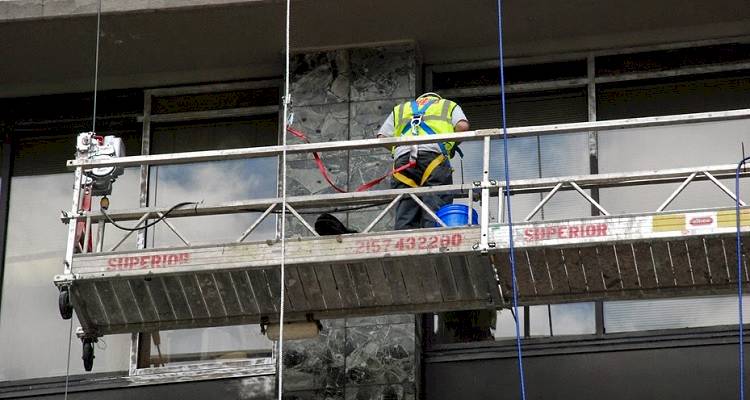
This type of scaffolding is often more expensive and complicated. It is not suitable for all projects, and it is mostly used for very large buildings.
Cantilever Scaffolding
A scaffold built off needles/supports from the structure when you can’t build from ground level (e.g., to avoid blocking a footpath). Requires a design and competent erection.
The scaffolding is supported from the top of the building and then built down from there. It allows access to difficult-to-reach places. If used in particularly tall buildings, workers also require harnesses for safety.
Haki Scaffolding
HAKI is a proprietary system scaffold. It’s lightweight, strong and versatile, and can be configured for many applications — including suspended work where designed for it.
Mast Climbing Work Platforms (MCWPs)
MCWPs are powered platforms that travel up and down a mast to give access at height. They’re not “scaffolding” in the tube-and-fitting sense and have their own standards and inspection regimes.
Rolling/Mobile Scaffolding
As the name suggests, this type of scaffolding can be moved from place to place.
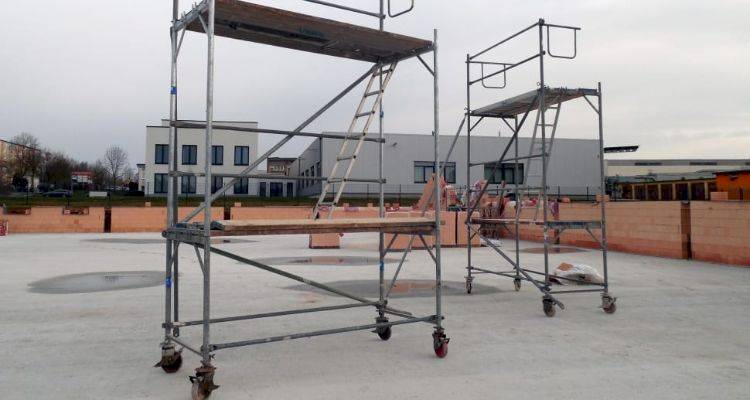
Maintenance of the wheels is very important as it can be dangerous to use this sort of scaffolding when the wheels are not in perfect working order. This type can be used for both interior and exterior projects.
Trestle Scaffolding
This style of scaffolding does not use standards. Instead, tripods or ladders are used to support the boards.
This scaffolding can be put on wheels and moved easily. Only use within the manufacturer’s stated limits and with suitable guardrails. For mobile access towers built to EN 1004-1, typical maximum freestanding platform heights are up to ~8 m outdoors and ~12 m indoors (design dependent).
Tower Scaffolding
Scaffolding towers are quick to put up and easy to move. They are used where it is necessary to move the scaffolding a lot during the course of the work.
They are built as compact combinations of scaffold and can be used for both indoor and outdoor jobs.
Users must be competent and follow the instruction manual; towers should be inspected before first use and at least every 7 days.
Scaffolding Regulations
If you’re hiring scaffolding, there are a few important safety rules set out by the Health and Safety Executive (HSE) under the Working at Height Regulations. These are in place to keep workers and the public safe.
- Scaffolding is classed as work at height, so it falls under the HSE’s Working at Height Regulations 2005.
- It must be erected, altered, and dismantled by someone capable (in other words, a trained scaffolder, or a team working under the supervision of one).
- All scaffold structures must be inspected by a competent person before first use, at least every 7 days, and after significant changes, high winds or events that could affect stability.
- Scaffold design should allow for guardrails, toe boards, and safe access. Netting or sheeting may be required if there’s a risk of falling debris.
- Any work at height should be risk assessed in the right way. The aim is always to avoid working at height where possible, and if not, to keep it safe and minimise time spent up there.
If any part of the scaffold encroaches on a pavement or road, a licence from the local highway authority is a legal requirement under the Highways Act 1980 (s.169).
If a scaffolding company doesn’t follow these rules, the HSE can issue fines or stop work on site. That’s why it’s essential to choose a reputable scaffolder and check they’re fully trained and insured.
If you’re unsure, the safest option is to speak to local scaffold specialists. They’ll explain what’s needed for your project and make sure everything is compliant from day one.
Removing Scaffolding
Removing scaffolding is called striking. It will be done at the end of your hire time. The cost of striking the scaffolding will be included in the scaffolding hire costs. It is essentially the reverse of setting up the scaffolding.
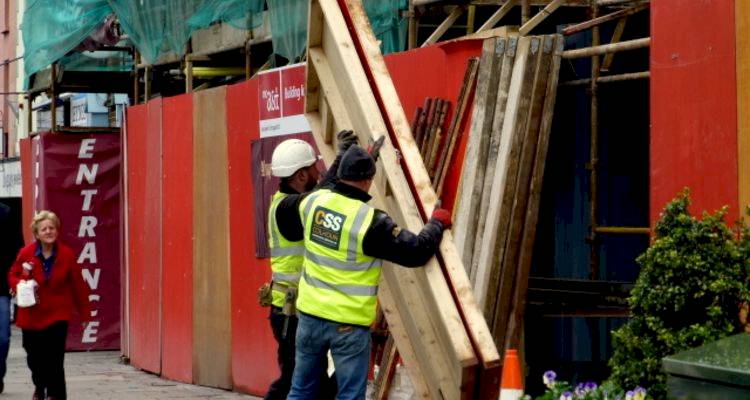
Dismantling should be done by a competent person — for towers that means someone properly trained and following the manual; for fixed/tube-and-fitting scaffolds, use qualified scaffolders. It’s never a one-person job.
Checklist: Hiring a Scaffolder in the UK
Before you book in your local scaffolder, take a quick look at these checks.
- Are they CISRS-qualified? Ask to see a valid CISRS card — the industry-recognised scaffolder qualification scheme in the UK. No card, no thanks.
- Do they carry public liability insurance? You want proof in writing. It protects you if something or someone gets spoiled on site.
- Are they with a recognised body? NASC contractor membership is widely seen as a quality mark because members are audited and follow industry guidance (e.g., TG20).
- What exactly is in the quote? Check it covers delivery, construction, weekly hire, inspections, netting/guardrails if needed, and striking (take-down).
- Who’s sorting out permits? If the scaffold touches a pavement or road, a licence is needed. A decent firm will sort this and build it into the timeline.
- How will it be inspected? You’re looking for a plan to inspect before first use, then every 7 days, and after bad weather or any change.
- Can they show similar jobs and reviews? A few photos and recent feedback tell you far more than a sales pitch ever will.
FAQS
Can I fit scaffolding myself?
Not advisable for most fixed scaffolds. By law, scaffolds must be erected, altered and dismantled by a competent person. For mobile access towers, that can include someone who’s properly trained and follows the manufacturer’s instructions. For tube-and-fitting or complex work, use qualified scaffolders. If any part touches a pavement or road, a highway licence is required. In practice, book a reputable scaffolder and let them handle permits, inspections and sign-off.
How long can scaffolding stay up?
Most hires start at 6–8 weeks, then roll on week-by-week if you need longer. Whatever the timescale, the scaffold must be checked before first use, every 7 days after that, and again after any alterations or rough weather.
What happens if the weather’s bad?
Strong winds, ice or storms can pause work or delay putting it up/taking it down. Once the weather settles, the scaffold needs a fresh safety inspection before anyone climbs back on. Timelines might slip a touch — a good firm worth its salt will keep you updated.
Do I need to be at home when it goes up?
Not essential, but helpful on day one. Clear access (move cars, bins and garden furniture). Also, keep pets indoors, and point out anything delicate (glass roofs, planters, ponds). That way, the crew can protect it properly.
Can I add my own bits (sheeting, lights, signs?
No, it’s best to leave it to your local scaffolder. Extra weight or fixings can affect how the scaffold behaves. If you want debris netting, sheeting or temporary lighting/signage, ask the scaffolder to supply and fit it safely.





